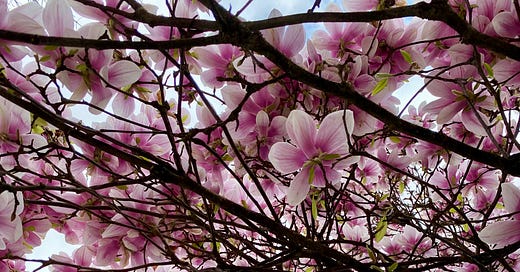March 2025
Dear friend,
🌳 First, a silly note: it’s my 30th birthday next week, and I haven’t had time to plan much of a celebration for this illustrious milestone (though the spring sunshine is a lovely start). But I would feel fêted indeed by an offering of nature-plant-place noticings and observations from my green-curious friends in the comments or by email. This kind of generous conversation is my favorite thing about writing Anne of Green Places. And if you know others who enjoy exploring green places, helping them find this one would be the best present of all. 🌳
As spring gets busy here, I have also been busy recreating my camera roll from last spring: documenting the tenderness of cherry blossoms and maple flowers, the shy raising of green flags on the tuliptrees, the continued yellow surge of forsythia and cornel and the new yellow surge of daffodils and lesser celandine, the glorious abundance of flowering magnolias, the newness and eagerness of everything. Most unfurlings are happening a week or two later than last year. I was thinking about making a side-by-side gallery of 2024 spring and 2025 spring, as I remembered even in the act of taking this year’s pictures1 the stored-away echoes of yellow and green and pink and sun dropping on the drifting plum petals and the trees full of bees. But I think you understand.
(One can always revisit my 2024 Detail Diary: magnolias galore.)
As there are always more Details, there are of course a few new entries this year. For example—having first noticed the Persian ironwood tree in the arboretum for the first time last fall, on March 3 (#433) I began to learn about its spring self, its maroon clusters of tiny, pendulous flowers that are apparently as irresistible to bees as the cherry and plum blossoms. On March 6, I heard the quirky whisper song of a magpie. On March 19 (#447), I found a male yew tree with pollen cones ripe to bursting. On March 22, I found a mating pair of two very different fuzzy bees on a daffodil and went on a small iNaturalist quest to identify them. On March 24 (#452), I happened on a head-to-tail train of pine processionary caterpillars crossing the arboretum path, a delightful and strange sight with unfortunate baggag (damage to pine trees and potentially dangerous irritation to human skin and curious dogs).
I also got one snow day upslope from Grenoble, cross-country skiing in Chamrousse, and took a trip to Germany and the Netherlands.
Read on for the Details…
🍃 Here is your usual reminder that this post is best viewed on the web or in the Substack app. (From email, click on the title of the post or “Read in app.”) Clicking on a Note will also take you to the browser/app to see its full text and additional photos. (If you’re in email and only see one photo per Note, chances are there are more.) 🍃
🌱 For an introduction to my Detail Diary, see here, or peruse past volumes. 🌱
🌿 Subscribe for free to get these updates and more place-and-plant stories in your inbox. 🌿
With input from iNautralist, we conclude that the two bees are a mating pair of Osmia cornuta, the European orchard bee. The larger one is the female. (And apparently there’s a whole page on iNaturalist just for observations of mating bees.)
A week’s travels: touristing in northern Germany (Bremen and Hamburg), then just over the border to the University of Twente near Enschede, Netherlands for a scientific meeting.







It is so lovely to receive all these by email to be able to catch up when I can, especially as I seem only sporadically to make it to Notes right now. Thank you, as always, and I hope you had a very merry birthday!
Happy, happy birthday!